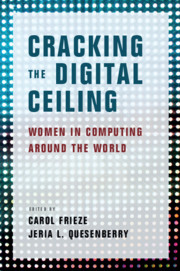Book contents
- Cracking the Digital Ceiling
- Cracking the Digital Ceiling
- Copyright page
- Contents
- Contributors
- Acknowledgments
- Introduction
- Part I Global Perspectives
- Part II Regional Perspectives
- Part III Cultural Perspectives from the United States and Europe
- 7 Against All Odds
- 8 Cultures and Context in Tech
- 9 Perspectives of Women with Disabilities in Computing
- 10 An Interview with Dr. Sue Black, OBE, Computer Scientist and Computing Evangelist
- 11 An Overview of the Swedish Educational System with a Focus on Women in Computer Science
- 12 Portugal
- 13 Women in Computing
- Part IV Cultural Perspectives from Asia-Pacific
- Conclusion
- Notes
- Index
- References
7 - Against All Odds
Culture and Context in the Female Information Technology Professional’s Career Choice and Experiences
from Part III - Cultural Perspectives from the United States and Europe
Published online by Cambridge University Press: 10 October 2019
- Cracking the Digital Ceiling
- Cracking the Digital Ceiling
- Copyright page
- Contents
- Contributors
- Acknowledgments
- Introduction
- Part I Global Perspectives
- Part II Regional Perspectives
- Part III Cultural Perspectives from the United States and Europe
- 7 Against All Odds
- 8 Cultures and Context in Tech
- 9 Perspectives of Women with Disabilities in Computing
- 10 An Interview with Dr. Sue Black, OBE, Computer Scientist and Computing Evangelist
- 11 An Overview of the Swedish Educational System with a Focus on Women in Computer Science
- 12 Portugal
- 13 Women in Computing
- Part IV Cultural Perspectives from Asia-Pacific
- Conclusion
- Notes
- Index
- References
Summary
Since 2006–2007, I have interviewed numerous women in technology careers to understand their motivation for choosing their careers and their experiences in the technical workforce. While the intent of an initial study that emerged from some of these interviews (Adya, 2008) was to compare and contrast the experiences of South Asian and American women in the US workforce, the stories of some of these women were more broadly impactful. Some of these women were inspiring in how they overcame barriers and eventually succeeded in information technology (IT) careers, and others in how they changed the course of their lives, sometimes away from IT careers and into others that they felt they could grow into.
Information
- Type
- Chapter
- Information
- Cracking the Digital CeilingWomen in Computing around the World, pp. 121 - 141Publisher: Cambridge University PressPrint publication year: 2019
References
Accessibility standard: Unknown
Why this information is here
This section outlines the accessibility features of this content - including support for screen readers, full keyboard navigation and high-contrast display options. This may not be relevant for you.Accessibility Information
- 1
- Cited by
